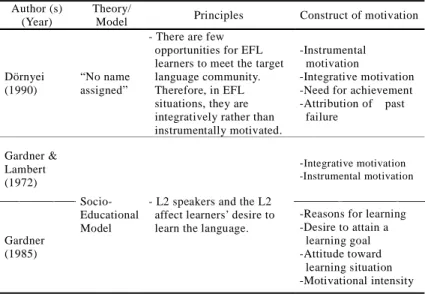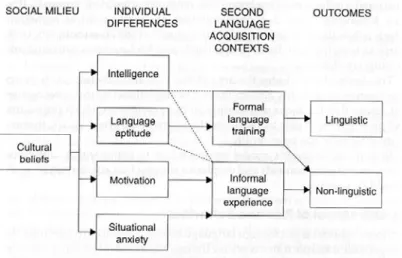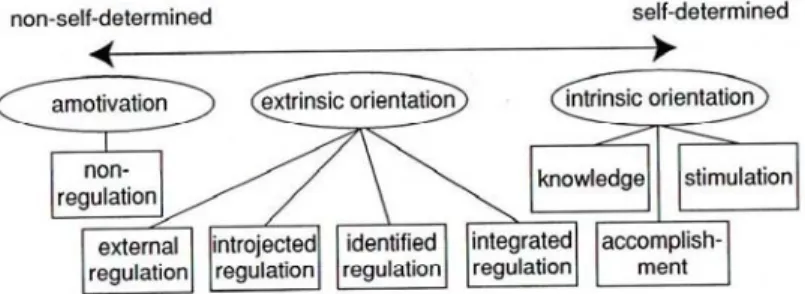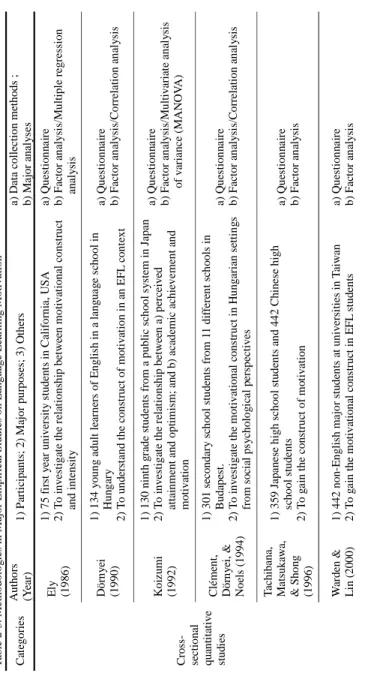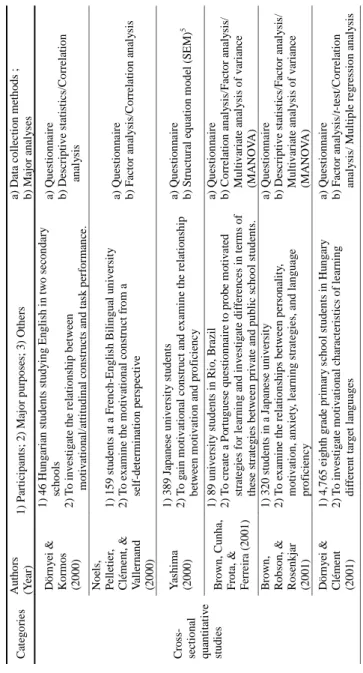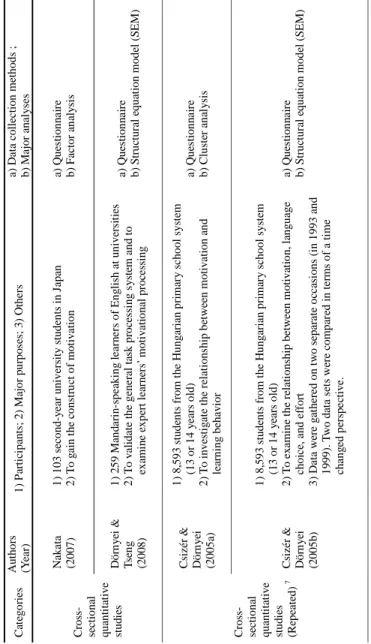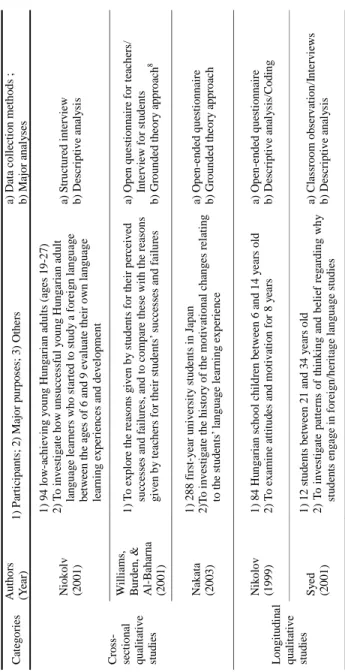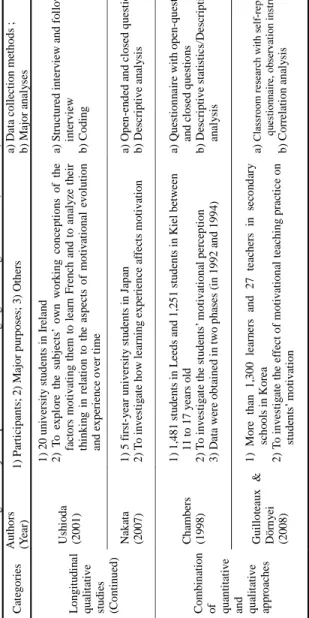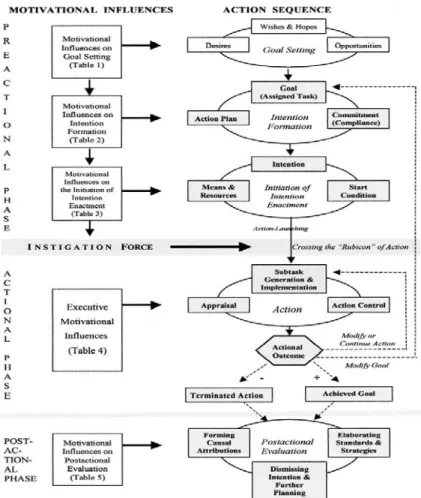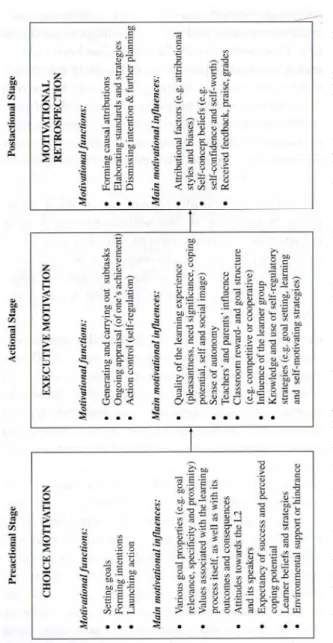I don't like English. A Comprehensive Study of Motivating EFL Students in the Japanese Secondary School Context
その他のタイトル 日本人中学生英語学習者の動機づけ方法に関するク ラス・ルーム研究 : 英語嫌いをなくすために
著者 Sugita Maya year 2009‑09‑20
学位授与機関 関西大学
学位授与番号 34416甲第338号
URL http://doi.org/10.32286/00000051
“I don’t like English.”
A Comprehensive Study of Motivating EFL Students in the Japanese Secondary School Context
---
A Dissertation Submitted to
The Graduate School of Foreign Language Education and Research, Kansai University
---
In Partial Fulfillment of the Requirements for the Degree Doctor of Philosophy in Foreign Language Education and Research
---
by SUGITA, Maya March 31, 2009
© Copyright by SUGITA, Maya, 2009
This dissertation of SUGITA, Maya is approved.
Doctoral Committee:
Professor Osamu Takeuchi, Ph.D. (Chair) Professor Tomoko Yashima, Ph.D.
Professor Atsuko Kikuchi, Ph.D.
Professor Yoshiyuki Nakata, Ph.D.(External)
Graduate School of Foreign Language Education and Research, Kansai University, Osaka, Japan.
2009
I
1950
(Construct)
9
2 130
II
3 5
1
2
3
4 3
(Proficiency)
III 5
4 8 5
4 1
124 Dörnyei(2001a)
MANOVA t
15
5 2 15
5 190
15 15 5
IV
6 3
motivational influences : MI 120 MI
3 MI MI
MI
a b
3 1
7
4 1,141
MI 6
V
MI
8 5 4
9 5
1 2
3 4 MI
MI a)
academic event
b
VI A) B) C)
i
Acknowledgements
Completing this dissertation has been the greatest challenge of my life. On the way, I was encouraged and supported by many people. I would like to express a few words of thanks to them. First and foremost, I express my heart-felt gratitude to Professor Osamu Takeuchi, my Ph.D. supervisor and my mentor, who introduced me to the topic of this dissertation. His patience, constant help, numerous suggestions, and unbelievable inspiration were the biggest motivators for me in the process of the research reported in this dissertation. His thorough and constructive comments have greatly contributed to enriching this dissertation in terms of both its content and its format.
Second, I am grateful to the internal examiners of my dissertation: Professors Tomoko Yashima and Atsuko Kikuchi, both of whom spared no words of advice and encouragement to me along the way. My deep gratitude also goes out to Professor Yoshiyuki Nakata at Hyogo University of Teacher Education, who kindly accepted the external examiner position. It was a great honor for me to receive their expert comments.
I would like to thank the Kyoto City Board of Education and the principals of the junior high schools in Kyoto City, who kindly allowed me to have access to the teachers and students in their schools. I am especially thankful to Ms. Misato Chojya, the Principal of Kyoto Oike Junior High School, and Mr. Yukio Ikegami, then the vice principal of the school. My genuine thanks also go out to Mr.
Yoshitsugu Kawaguchi and Mr. Keiichi Araki of the English Education Research Society for Junior High School Teachers in Kyoto City and Mr. Toshiya Taguchi of the Kyoto City Board of Education.
The ideas contained in this dissertation are the result of the contributions from many teachers and students who participated in the research project. I would especially like to thank Ms. Ayumi Ikeda, an English teacher at Kyoto Oike Junior High School, for demonstrating to me what teachers should do in motivating their students. My special thanks are also due to Ms. Nobuko Hishida, Mr. Daisuke Teranishi, Ms. Mitsuki Minami, Mr. Kenta Ando, Mr. Yugo Ishida, and Ms.
Tomoko Sawamura of Kyoto Oike Junior High School, who had always worked together with me. Needless to say, many thanks go out to every student who participated in this research project. Without their cooperation, I would not have completed this dissertation.
I have been fortunate to have had many good colleagues and friends at the Graduate School, who gave me detailed suggestions on how to improve this dissertation. My sincere gratitude is due to Dr. Maiko Ikeda, who kindly read the entire manuscript and gave me insightful comments. I am also grateful to Dr.
Atsushi Mizumoto, Mr. Seijiro Sumi, Dr. Tomoko Yabukoshi, and Ms. Yuka Yamanaka (in alphabetical order) for their constant help and inspiration.
Finally, I dedicate this dissertation to my parents, Shingo and Sayoko Sugita, who provided me with invaluable support and precious love during a difficult period along the way toward the completion of my research project.
Table of Contents
Acknowledgements……….………. i
1. Introduction………. 1
2. Literature Review………..…………... 4
2.1 Review on Major Motivation Theories……… 4
2.2 Three Characteristics of Motivation……… 10
2.3 Methodological Issues in Language Learning Motivation Research…. 13 2.4 An Emerging Trend in Motivation Research in L2………. 22
2.4.1 Criticisms against Existing Theories……….... 22
2.4.2 Motivation Research for Pedagogical Purposes………... 24
2.4.3 Studies on Motivational Strategies………... 28
2.5 What Could be Investigated in the Japanese EFL Context? ………….. 37
2.6 Summary……… 39
3. Research Design……….. 43
4. Study 1………. 47
4.1 Purposes……… 47
4.2 Definition of Motivational Strategies………. 47
4.3 Method……….. 48
4.3.1 Participants……… 48
4.3.2 Data Collection………. 49
4.3.3 Data Analysis……… 49
4.4 Results and Discussion……… 50
4.4.1 Most and Least Necessary Motivational Strategies……….
50 4.4.2 Effect of Teaching Experience, Grade, and Gender on Teachers’
perception………..………..……….. 54
4.5 Summary………..………. 58
5. Study 2……….……… 61
5.1 Introduction………... 61
5.2 Purposes……….... 61
5.3 The 15 Motivational Strategies……… 61
5.4 Method……….. 62
5.4.1 Participants……… 62
5.4.2 A Questionnaire for Teachers……… 64
5.4.3 A Questionnaire for Students……… 65
5.5 Results and Discussion………. 66
5.5.1 Findings in Frequency Count……… 66
5.5.2 Relationships Between Strategy Use and Motivation………. 70
5.6 Summary……… 75
6. Study 3………. 78
6.1 Introduction………... 78
6.2 Purposes………. 78
6.3 Definition of Motivational Influences………... 79
6.4 Participants……… 79
6.5 Instruments and Procedure………... 80
6.6 Data Analysis……… 81
6.7 Results……….. 82
6.7.1 Categories Obtained from Journal Entries……….. 82
6.7.2 Changes in the Students’ Perception of Motivational Influences... 87
6.7.3 Learning Time and Strength of Motivation………. 88
6.7.4 Changes in Motivational Influences according to Proficiency Level………..……….……….. 90
6.8 Discussion………. 91
6.9 Summary………... 93
7. Study 4………. 95
7.1 Introduction……….. 95
7.2 Method……….. 95
7.2.1 Participants……… 95
7.2.2 Data Collection………. 96
7.2.3 Statistical Analysis……… 97
7.3 Results and Discussion……… 98
7.3.1 Results of the Factor Analysis………. 98
7.3.2 Relationships among Motivational Influences and Students’ Proficiency of English………. 100
7.4 Summary……….. 104
8. Study 5……… 106
8.1 Introduction……….. 106
8.2 Participants……….. 106
8.3 Method………. 111
8.4 Results and Discussion……… 112
8.4.1 Research Question 1………. 112
8.4.2 Research Question 2………. 115
8.4.3 Research Question 3………. 119
8.4.4 Research Question 4………. 124
8.5 Summary……… 130
9. Conclusion……….. 133
References……… 140
Appendices……….. 166
Appendix A. Original letter requesting cooperation from junior high school teachers……… 166
Appendix B. Translated version of the letter requesting cooperation from junior high school teachers………..……… 168
Appendix C. Original questionnaire used in Study 1………... 170
Appendix D. Translated version of the questionnaire used in Study 1….. 175
Appendix E. Original questionnaire for assessing teachers’ motivational strategies used in Study 2……..……….. 180
Appendix F. Translated version of the questionnaire for teachers’ motivational strategies used in Study 2……..……….... 182
Appendix G. Original questionnaire for assessing students’ motivation used in Study 2………....………. 184
Appendix H. Translated version of the questionnaire for assessing students’ motivation used in Study 2…..……….... 187
Appendix I. Journal format used in Study 3………. 190
Appendix J. Translated version of journal format used in Study 3…….... 191
Appendix K. A sample description obtained from a participant in journal………..………. 192
Appendix L. Translated version of a sample description obtained from a participant in journal..………. 193
Appendix M. A graphical representation of Table 6-2 (1) ………. 194
Appendix N. A graphical representation of Table 6-2 (2) ……….. 195
Appendix O. Original questionnaire used in Study 4……….. 196
Appendix P. Translated version of the questionnaire used in Study 4…… 199
There are only three things of importance to successful learning:
motivation, motivation, and motivation. (Ball, 1995, p.5)
1. Introduction
“I don’t like (learning) English!”
is what EFL teachers in Japanese secondary schools1 often hear from their students. Even faced with such harsh words, they still encourage their students to keep learning English, sometimes, in vain.The greatest concern that many EFL practitioners in Japan have faced in recent years is how to motivate their students to learn English. For the three years in which the author worked as an EFL teacher at a public secondary school, she found it extremely difficult to make her students realize the necessity of learning English and keep them motivated to learn it. She was frequently asked by her students, “Why do I have to learn it? I don’t like (learning) English!” She was unable to provide a good answer to the question at that time. And still now, after leaving the secondary school for her post-graduate study, she is struggling to find a good answer.
In her three-year teaching experience, the author noticed that not only she but also many other EFL teachers had spent a lot of time thinking about how they could motivate their students to learn English. She also found that teachers had consciously or unconsciously discussed the issue on various occasions. One of the teachers who had worked with the author said in a casual conversation with her;
We bear responsibility for motivating our students. Because they have just started learning English and must keep on learning it until they are at the university level. They will have to study English during many years to come even, like it or not. There is no way to
avoid it. So we bear full responsibility for motivating our students to study English intensely at this early stage of learning…
(Translation mine)
While many practitioners are, as described above, constantly thinking about their students’ level of motivation, some researchers (e.g., Koizumi & Matsuo, 1993; Nakata, 2001) have observed that the level of students’ motivation declines gradually during the course of the three years in secondary school. Despite the tireless efforts made by the practitioners, we thus can say that the necessity of finding effective ways to motivate students to learn English has not diminished at all in Japan. It has remained the same. Furthermore, as Cheng and Dörnyei (2007, p.154) argue, empirical data concerning the ways to motivate EFL students are scarce. Much more data should therefore be provided so that we can have a solid foundation on which our teaching practice can stand.
In the following chapters, the efforts made by the author to provide the much-needed empirical data concerning how to motivate Japanese secondary school students to learn English are to be reported. Before getting down to the empirical studies, however, a literature review is in order. In the next chapter, the author will thus review some 130 studies on language learning motivation and formulate the research questions to be treated in the ensuing chapters.
Note
1. Generally speaking, secondary schools include both upper and lower secondary schools. In this dissertation, however, the author would like to limit this term to include lower secondary (i.e., junior high) schools only.
2. Literature Review
Researchers and teachers believe that “motivation” has a great influence on how much learners like learning languages, how well they perform in various activities, how high their proficiency/achievement levels may become, and how long they can keep learning languages (e.g., Dörnyei, 2006; Oxford & Shearin, 1994). In a sense, motivation is a major factor for success in language learning (e.g., Dörnyei, 2001c; Gardner & Lambert, 1972). Over the course of many decades, an enormous amount of research on motivation in language learning has been conducted and extensive knowledge has been accumulated. In this chapter, in order to determine what remains to be investigated in future research, the author reviews major studies on language learning motivation, considering its theories, nature, research methodologies, and recent trends.
2.1 Review on Major Motivation Theories
During the past few decades, many theories concerning motivation have been proposed. Until the beginning of the 1990s, these theories aimed to clarify the construct of motivation. Table 2-1 shows a summary of the major theories and models that have been proposed to identify the construct of motivation in the field of psychology, while Table 2-2 shows those in the L2 field (for the detailed reviews, see Dörnyei, 2001a, 2001c; Oxford & Shearin, 1994).
Table 2-1. Major Language Learning Motivation Theories in Psychology Author (s)
(Year)
Theory/
Model Principles Construct of motivation
Atkinson (1964)
Expectancy Value Theory
- Engagement in
achievement-oriented behavior is a function not only of the motivation for success but also of the probability of success (expectancy) and the incentive value of success
- Learners are positively motivated when they meet with success and appreciate the value of goals.
-Expectancy of success in a task
-The value the individual attaches to success
Bandura (1977, 1997)
Self-Efficacy Theory
- Learners’ perceived efficacy will influence their performance and determine their choice of the activities.
-Previous performance -Vicarious learning -Verbal encouragement
by others -One’s psychological
reactions
Deci & Ryan (1985)
Self- Determination
Theory
- Learners’ motives can be placed on a continuum between self-determined (intrinsic) and controlled (extrinsic) forms of motivation.
- People are motivated more by their own will (intrinsic) than by something that they are forced to do (extrinsic).
-Intrinsic motivation -Extrinsic motivation,
which is divided into three levels: a) external regulation; b) introjected regulation;
and c) identified regulation )
Locke &
Latham (1990)
Goal Setting Theory
- Performance is closely related to an individual’s accepted goals.
- Concerning goals, a) goal-setting and performance are related; b) goals affect task performance;
and c) specific goals produce higher performance levels, etc.
-Goal-settings
Table 2-2. Major Language Learning Motivation Theories in L2 Author (s)
(Year)
Theory/
Model Principles Construct of motivation
Dörnyei (1990)
“No name assigned”
- There are few opportunities for EFL learners to meet the target language community.
Therefore, in EFL situations, they are integratively rather than instrumentally motivated.
-Instrumental motivation
-Integrative motivation -Need for achievement -Attribution of past
failure
Gardner &
Lambert (1972)
Socio- Educational Model
- L2 speakers and the L2 affect learners’ desire to learn the language.
-Integrative motivation -Instrumental motivation
Gardner (1985)
-Reasons for learning -Desire to attain a
learning goal -Attitude toward
learning situation -Motivational intensity
Many of the L2 motivation studies have been strongly affected by the Gardner and Lambert’s theory (1972), which was formulated from a social psychological perspective (Figure 2-1). Gardner, along with his associates, focused on motivation (reasons for language learning) among English-speaking students in a Canadian ESL context (e.g., Clément & Gardner, 2001; Gardner &
Lambert, 1972; Gardner & MacIntyre, 1991, 1993; Masgoret & Gardner, 2003;
Temblay & Gardner, 1995).
Figure 2-1. Gardner’s socio-educational model in 1985 (cited in Chamber, 1999).
In their study, language learning motivation was divided into two types: a) integrative motivation; and b) instrumental motivation. Integrative motivation refers to “a desire to learn the L2 in order to have contact with, and perhaps to identify with, members from the L2 community” and reflects a genuine interest in learning the second language in order to come closer to the other language community (Gardner, 2001a, p.5). In contrast, instrumental motivation refers to “a desire to learn the L2 to achieve some practical goal, such as job advancement or course credit” (Noels, Pelletier, Clément, & Vallerand, 2000). For many years, several surveys using this dichotomy were conducted and researchers focused mainly on “integrative motivation” (e.g., Dörnyei, 1994; Gardner, 1985; Yashima, 2000; among others). Nakata (2007, p.53) mentioned that the importance of integrative motivation in language learning received worldwide attention and
became a primary focus of subsequent research (e.g., Clément, 1980; Giles &
Byrne, 1982).
Although focusing on integrative motivation had been mainstream in language learning motivation research up until the end of 1980s, several problems appeared when the social psychological approach was applied to other contexts. Some researchers (e.g., Au, 1988; Oller, 1981) criticized the concept of
“integrative motivation” as not being applicable to non-bilingual contexts. At the beginning of the 1990s, studies on motivation thus shifted their focus to differences in motivation between second language (SL) and foreign language (FL) situation, and paid more attention to instrumental motivation in FL contexts (e.g., Clément, Dörnyei & Noels, 1994; Dörnyei, 1990; Crookes & Schmidt, 1991;
Samimy & Tabuse, 1992). For example, Oxford (1996) suggested that EFL is a different context from ESL and that instrumental motivation should thus be a main focus of research on motivation in that context. In addition, Dörnyei (1990) argued that as learners in EFL contexts do not have enough experience working in the target language community, special attention should be paid to instrumental motivation. He also suggested that instrumental goals indeed play a prominent role in the learning of English up to an intermediate level.
These studies have so far discussed which motivation (i.e., integrative/
instrumental) has affected learning behavior and which motivation has worked effectively to influence language learning achievement or proficiency in each cultural context.1 Another influential line of research was introduced to this field from educational psychology by Deci and Ryan (1985); Noels later applied their ideas to L2 learning (Figure 2-2). Deci and Ryan divided motivation into two types: “intrinsic”2and “extrinsic.” Intrinsic motivation refers to “reasons for L2
learning that are derived from one’s inherent pleasure and interest in the activity;
the activity is undertaken because of the spontaneous satisfaction that is associated with it” (Noels, 2001, p.45), while extrinsic motivation refers to “reasons that are instrumental to some consequence apart from inherent interest in the activity”
(Noels, 2001, p.46).
Figure 2-2. Orientation subtypes along the self-determination continuum (Ryan &
Deci, 2000).
Some researchers (e.g., Deci, 1971, 1972; Lepper, Greene, & Nisbett, 1973) found that learners decreased their intrinsic interest in a given task if they met some extrinsic requirements. On the other hand, there were some studies (e.g., Harackiewicz, 1979; Iwawaki, 1996; Ryan, 1982) that did not support the trade-off relationship between the two types of motivation. As is the case with the integrative and instrumental distinction, they argued that extrinsic and intrinsic motivations are different and not related constructs.
These theories have provided us with a lot of information regarding what
components language learning motivation includes. However, they focused on the motivational construct among adult learners. Some researchers have argued that among younger learners, these factors of motivation might not be distinguishable3 (e.g., Hayamizu, 1997; Koizumi & Matsuo, 1993; Olshtain, Shohamy, Kemp, &
Chatow, 1990; Sugita & Takeuchi, 2008). Empirical data on the motivational construct among young learners, however, are still scarce and thus need to be accumulated in future studies.
In this sense, the previous studies did not concentrate on how the teachers could apply these theories to their actual instructional settings and also never explicitly addressed classroom implications. Admitting this inadequacy at around the end of the 1990s, many researchers (e.g., Chambers, 1999; Dörnyei, 2001c;
Dörnyei & Csizér, 1998) began to shift their focus from, “the construct of motivation,” to, “the way to enhance the motivation in the language classroom.”
2.2 Three Characteristics of Motivation
As was explained above, many theories and models were developed until the end of the 1990s. In them, researchers often referred to the following three characteristics of motivation: 1) it is a multi-faceted concept; 2) it is inconstant;
and 3) it is unobservable. When it comes to motivation research, these three characteristics need to be kept in the researchers’ minds. The author thus explains these characteristics one by one.
1) Motivation is a multi-faceted concept (e.g., Dörnyei, 2001c; Gardner, 1985;
Nakata, Kimura, & Yashima, 2003).
The term of “motivation” includes: 1) why do people decide to do something?; 2) how long are they willing to sustain the activity?; 3) how hard are they going to pursue it?
(Dörnyei, 2001c, p.8)
That the motivation includes three components: 1) motivational intensity; 2) desire to learn the language; 3) attitudes towards learning the language.
(Gardner, 1985)
Dörnyei mentioned that motivation is best seen as a board of umbrella terms that cover a variety of meanings. He also claimed that motivation is an abstract, hypothetical concept that we use to explain why people think and behave as they do. Boekaerts (1995, p.2) also described motivation as a blanket term that refers to a variety of cognitions and affects (e.g., self-efficacy, expectancy). Thus, it is responsible for all researchers to define “what motivation is” in their research.
2) Motivation is inconstant (e.g., Dörnyei, 2001c; Nakata, et al, 2003).
Motivation is not a relatively constant state but rather more dynamic entity that changes over time, with the level of effort
invested in the pursuit of a particular goal oscillating between regular ups and downs. (Dörnyei, 2001c, p. 41)
Most of the studies on motivation have touched on the temporal nature of motivation. Dörnyei (2001c, p. 195) claimed;
“as the relative absence of longitudinal studies in L2 motivation research indicates, few researchers have the necessary resources or choose to accept the long waiting period associated with longitudinal designs. On the other hand, most scholars would agree that longitudinal studies can offer far more meaningful insights into motivational matters than cross-sectional ones.”
Researchers therefore should focus on the dynamic (i.e., changing) nature4 of motivation in future research.
3) Motivation is unobservable (e.g., Dörnyei, 2001c).
Motivation is an abstract that refers to various mental (i.e., internal) processes and states. It is therefore not subject to direct observation but must be inferred from some indirect indicator, such as the individual’s self-report’s accounts, overt behaviors or psychological responses.(Dörnyei, 2001c, p. 185)
Dörnyei (2001c, p. 207) also claimed that, “while no one would deny that self-report instruments are vulnerable to extraneous influences, we must recognize that there is no better alternative of measuring the unobservable construct of motivation.”
These three characteristics are so important that, when it comes to research on motivation, every researcher needs to keep them in mind.
2.3 Methodological Issues in Language Learning Motivation Research Researchers conducted not only theoretical studies but also empirical studies on motivation research. Regarding empirical research, various methodologies have been introduced to collect data. Nakata (2006) explained the methodologies used in language learning motivation research from four perspectives:1) cross-sectional quantitative studies; 2) longitudinal quantitative studies; 3) cross-sectional qualitative studies; and 4) longitudinal qualitative studies. Cross-sectional studies typically sample the participants’ thoughts, behaviors, or emotional stances at one particular point in time, while longitudinal studies observe the participants for an extended period in order to detect changes and patterns of development over time.
Based on these distinctions, the author categorizes the empirical studies published in major journals (including treatises) and explains the details of methodologies in Table 2-3.
Among the four categories described above, “cross-sectional quantitative studies” have been the most frequently employed for language learning motivation research. A questionnaire with a Likert scale has so far been one main instrument used in this category, and “factor analysis” has been the most often-used method of analysis.
Table 2-3.Methodologies in Major EmpiricalStudies on Language Learning Motivation CategoriesAuthors (Year)1)Participants; 2) Major purposes; 3) Othersa) Data collection methods; b)Major analyses Cross- sectional quantitative studies Ely (1986)
1) 75 first year university students in California, USA 2) To investigate the relationship between motivational construct and intensity a) Questionnaire b) Factor analysis/Multiple regression analysis Dörnyei (1990)
1) 134 young adult learners of English in a language school in Hungary 2) To understandthe construct of motivation in an EFL context
a) Questionnaire b) Factor analysis/Correlation analysis Koizumi (1992)
1) 130 ninth gradestudents fromapublic school system in Japan 2) To investigate the relationship betweena) perceived attainment and optimism; and b) academic achievement and motivation
a) Questionnaire b) Factor analysis/Multivariate analysis of variance(MANOVA) Clément, Dörnyei, & Noels (1994)
1) 301 secondary school students from 11 different schools in Budapest. 2) To investigate the motivational construct in Hungarian settings from social psychological perspectives
a) Questionnaire b) Factor analysis/Correlationanalysis Tachibana, Matsukawa, & Shong (1996)
1) 359 Japanese high school students and 442 Chinese high school students 2) To gaintheconstruct of motivation a) Questionnaire b) Factor analysis Warden & Lin (2000)1) 442 non-English major students at universities in Taiwan 2) To gain the motivational construct in EFL studentsa) Questionnaire b) Factor analysis
Table 2-3. Methodologies in Major EmpiricalStudies on Language Learning Motivation (Continued) CategoriesAuthors (Year)1) Participants; 2) Major purposes; 3) Othersa) Data collection methods; b) Major analyses Cross- sectional quantitative studies Dörnyei& Kormos (2000)
1) 46 Hungarian students studying English in two secondary schools 2) To investigate the relationship between motivational/attitudinal constructsand task performance.
a) Questionnaire b) Descriptive statistics/Correlation analysis Noels, Pelletier, Clément,& Vallernand (2000)
1) 159 students at a French-English Bilingual university 2) To examine the motivational construct froma self-determination perspective
a) Questionnaire b) Factor analysis/Correlation analysis Yashima (2000)
1) 389Japanese university students 2) To gain motivational construct and examine the relationship between motivation and proficiency
a) Questionnaire b) Structural equation model(SEM) Brown, Cunha, Frota, & Ferreira (2001)
1) 89 universitystudents in Rio, Brazil 2) To create a Portuguesequestionnaireto probe motivated strategies for learning and investigate differencesinterms of these strategies between private and public school students.
a) Questionnaire b) Correlation analysis/Factor analysis/ Multivariate analysis of variance (MANOVA) Brown, Robson, & Rosenkjar (2001)
1) 320 studentsin a Japanese university 2) To examine the relationships betweenpersonality, motivation, anxiety, learning strategies, and language proficiency a) Questionnaire b) Descriptive statistics/Factor analysis/ Multivariate analysis of variance (MANOVA) Dörnyei& Clément (2001)
1) 4,765 eighth grade primary school students in Hungary 2) To investigate motivational characteristics of learning different target languages
a) Questionnaire b) Factor analysis/t-test/Correlation analysis/Multiple regression analysis Table 2-3. Methodologiesin Major EmpiricalStudies on Language Learning Motivation (Continued) CategoriesAuthors (Year)1) Participants; 2) Major purposes; 3) Othersa) Data collection methods; b) Major analyses Cross- sectional quantitative studies
Jacques (2001) 1) 21 teachers and 828 students at a University in Hawaii 2) To investigate teachers’and learners’motivation (preferences)in different instructional activities
a) Questionnaire b) Descriptive statistics/Correlation analysis/Factor analysis/ Multivariate analysis of variance (MANOVA) Kassabgy, Boraie, & Schmidt (2001)
1) 107 experienced ESL/EFL teachers from Egypt and Hawaii, USA 2) To investigate teachers’motivational character(i.e., values and satisfaction)in ESL/EFL instruction
a) Questionnaire (bothLikert-scale and open-ended questions) b) Factor analysis/Correlation analysis Kimura, Nakata, & Okumura (2001)
1) 1,027 Japanese EFL students from 12 different learning contexts that varied from junior high school to university 2) To gain the construct of motivation for EFL learners
a) Questionnaire b) Factor analysis/Multivariate analysis of variance(MANOVA) MacIntyre, MacMaster, & Baker (2001)
1) 153 high school students (ages 14 -19) 2) To examine the majormodels of motivationa) Questionnaire b) Structural equation model (SEM) Masgoret, Bernaus, & Gardner (2001) 1) 499 Spanish children ranging from ages 10-15 2) To examine the relationship betweenattitudes, motivation, anxiety, and self-perceptions of foreign language achievement in children
a) Questionnaire b) Factor analysis/Correlation analysis
Table 2-3. Methodologies in Major EmpiricalStudies on Language Learning Motivation (Continued) CategoriesAuthors (Year)1) Participants; 2) Major purposes; 3) Othersa) Data collection methods; b) Major analyses Cross- sectional quantitative studies Schmidt & Watanabe (2001)
1) 2,089 learners of five different foreign languages 2) To identify the combination of factors that define motivation and to identify relationships among those motivational factors, language learning strategies, and preferences for classroom activities a) Questionnaire b) Factor analysis/Correlation analysis/ Analysis of variance (ANOVA) Yashima (2002)
1) 389 Japanese University students 2) To investigate the relationship among L2 learning and communication variables using aWTC modeland asocio- educational model
a) Questionnaire b) Structural equation model (SEM) Yamamori, Isoda, Hiromori,& Oxford (2003)
1) 81 Junior high school students in Japan 2) To investigate the relationship between the will to learn (motivation), achievement, and learning strategies
a) Questionnaire b) Cluster analysis Kormos & Dörnyei (2004)
1) 44 Hungarianstudents at secondary schools 2) To examine how motivational factors affect the quality and quantity of students’performance in an L2 communicative task performed in dyads.
a) Observation(recorded) and Questionnaire b) Descriptive statistics/Correlation analysis Schmidt, Inbar, &Shohamy (2004)
1) 692 Jewish elementary school students and 362 parents 2) To investigate the effects of teaching Arabic on students’ attitudes and motivation
a) Questionnaire (both Likert-scale and open-ended questions) b) Factor analysis/Multivariate analysis of variance(MANOVA) Chen, Warden, &Chang (2005)
1) 567 EFL learners in Taiwan 2) To examine the relationship between themotivational construct,self-evaluation, and expectancy
a) Questionnaireon Web b) Factor analysis/Structural equation model (SEM) Table 2-3. Methodologies in Major EmpiricalStudies on Language Learning Motivation (Continued) CategoriesAuthors (Year)1) Participants; 2) Major purposes; 3) Othersa) Data collection methods; b) Major analyses Cross- sectional quantitative studies
Nakata (2007)1) 103 second-year university students in Japan 2) To gain the construct of motivationa) Questionnaire b) Factor analysis Dörnyei& Tseng (2008) 1) 259 Mandarin-speaking learners of English at universities 2) To validate the general task processing system and to examineexpert learners’motivational processing
a) Questionnaire b) Structural equation model (SEM) Cross- sectional quantitative studies (Repeated)
Csizér& Dörnyei (2005a) 1) 8,593 students from theHungarian primary school system (13 or14 years old) 2)To investigate the relationship between motivation and learning behavior
a) Questionnaire b) Cluster analysis Csizér& Dörnyei (2005b)
1) 8,593 students from theHungarian primary school system (13 or 14 years old) 2) To examine the relationship betweenmotivation, language choice,and effort 3) Data were gathered ontwo separate occasions (in 1993and 1999). Two data setswerecompared in terms of atime changed perspective.
a) Questionnaire b) Structural equation model (SEM)
Table 2-3. Methodologies in Major EmpiricalStudies on Language Learning Motivation (Continued) CategoriesAuthors (Year)1) Participants; 2) Major purposes; 3) Othersa) Data collection methods; b) Major analyses Cross- sectional quantitative studies (Repeated) Dörnyei& Csizér (2002)
1) 8,593 students from theHungarian primary school system (13 or 14 years old) 2) To investigate how the significant sociocultural changes that took place in Hungary in the 1990s affected school children’s language-related attitudes and language learning motivation concerning five target languages 3) Data were gatheredontwoseparate occasions (in 1993and 1999). Two data setswerecompared in terms of atime changed perspective.
a) Questionnaire b) Correlation analysis/Analysis of variance (ANOVA) Inbar, Schmidt, & Shohamy (2001)
1) 1,690 seventh grade students from nine heterogeneous junior high schools 2) To examine how the study of Arabic is related to motivation to learn the Arabic language and culture 3) Data were gatheredtwice usinga pre-test/treatment/ post-test design
a) Questionnaire b) Factor analysis/Multivariate analysis of variance(MANOVA) Longitudinal quantitative studies
Koizumi & Matsuo (1993) 1) 296 Japanese 7grade students learning English 2) To examine attitudinal motivational changes
a) Questionnaire b) Factor analysis/Analysis of variance (ANOVA) Yashima & Zenuk-Nishide (2008)
1) 165 High school students in Japan 2) To investigate the change ininternational posture and communicative tendencies
a) Questionnaire b) Analysis of variance (ANOVA)/ Cluster analysis Table 2-3. Methodologies in Major EmpiricalStudies on Language Learning Motivation (Continued) CategoriesAuthors (Year)1) Participants; 2) Major purposes; 3) Othersa) Data collection methods; b) Major analyses Cross- sectional qualitative studies
Niokolv (2001) 1) 94 low-achievingyoung Hungarianadults (ages 19-27) 2) To investigate how unsuccessful young Hungarianadult language learners who started to study a foreign language between the ages of 6 and 9 evaluate their own language learning experiences and development
a) Structuredinterview b) Descriptive analysis Williams, Burden, & Al-Baharna (2001)
1) To explore the reasons given by students for their perceived successes and failures, and to compare these with the reasons given by teachers for their students’successes and failures
a) Open questionnaire for teachers/ Interview for students b) Grounded theory approach Nakata (2003)
1) 288 first-year university students in Japan 2)To investigate the history of the motivational changes relating to the students’ language learning experience
a) Open-ended questionnaire b) Grounded theory approach Longitudinal qualitative studies
Nikolov (1999)1) 84 Hungarian school children between 6 and 14 years old 2) To examine attitudes and motivation for 8 years a) Open-ended questionnaire b) Descriptive analysis/Coding Syed (2001) 1) 12 students between 21 and 34 years old 2) To investigate patterns of thinkingand belief regardingwhy studentsengage in foreign/heritage language studies
a) Classroom observation/Interviews b) Descriptive analysis
Table 2-3. Methodologies in Major EmpiricalStudies on Language Learning Motivation (Continued) CategoriesAuthors (Year)1) Participants; 2) Major purposes; 3) Othersa) Data collection methods; b) Major analyses Longitudinal qualitative studies (Continued) Ushioda (2001) 1) 20 university students in Ireland 2) To explorethe subjects’own workingconceptions of the factors motivating them to learn French and to analyze their thinking in relationto the aspects of motivational evolution and experienceover time
a) Structured interview and follow-up interview b) Coding Nakata (2007)1) 5 first-year university students in Japan 2)To investigate how learning experience affectsmotivationa) Open-ended and closed questionnaire b) Descriptive analysis Combination of quantitative and qualitative approaches
Chambers (1998) 1) 1,481students in Leedsand 1,251students in Kiel between 11 to17 years old 2) To investigate the students’motivational perception 3) Data were obtained intwo phases (in 1992 and 1994)
a) Questionnairewith open-questions and closed questions b) Descriptivestatistics/Descriptive analysis Guilloteaux& Dörnyei (2008)
1) More than 1,300 learners and 27 teachersinsecondary schools in Korea 2) To investigate the effect of motivational teaching practiceon students’ motivation a) b) Correlation analysis
Dörnyei (2001c) mentioned that factor analysis has been the key technique in motivation research since the pioneering work of Gardner and Lambert (1959) was conducted. In order to uncover the latent structure that underlies large data sets, it reduces the number of variables submitted to the analysis to a few values that will contain most of the information found in the original variables (Hatch &
Lazaraton, 1991). However, most of these studies have explained only temporary dimensions of motivation. Recently, some researchers (Dörnyei, 2001c; Nakata, 2003, 2007) pointed out the lack of change-oriented perspectives in the previous motivation literature. To illustrate the changes in motivation, the importance of longitudinal research using a qualitative approach has thus been emphasized.
Major techniques for data collection in this type of study are interviews, open-ended questionnaires, observations, and so forth. However, these techniques require an investment of time and energy before any meaningful results can be obtained (Dörnyei, 2001c). Empirical studies using a longitudinal qualitative approach are therefore still scarce. In connection, Dörnyei (2001c) mentioned that the combination of qualitative and quantitative approaches might be a particularly fruitful direction for future motivation research.
2.4 An Emerging Trend in Motivation Research in L2 2.4.1 Criticisms against Existing Theories
As was mentioned in section2.1, during the past few decades, many theories on motivation have been rendered, and empirical studies have been conducted.
These theories and studies have so far discussed the construct of motivation and the question of which component of the construct might affect EFL/ESL English proficiency/achievement. Some researchers, however, criticized these studies as
follows:
When teachers say that students are motivated, they are not usually concerned with the students’ reason for studying (i.e., motivation orientation), but that the students do study, or at least are engaged in teacher-desired behavior in the classroom and possibly outside of it. (Crookes & Schmidt, 1991, p. 480)
From a practicing teachers’ point of view, the most pressing question related to motivation is not what motivation is but rather how it can be increased. (Dörnyei, 2001b, p. 51 )
Although famous constructs of integrative and instrumental motivation are useful in understanding the language learners’
positioning of the target language in their social world, they do not answer the language practitioners’ questions such as “How can teachers motivate their students to learn and continue to learn the target language?”
(Namura, Ikeda, & Yashima, 2007, p. 170)
As is shown in the quotations above, we can see that two important issues, how to motivate language learners and how to maintain their high motivation, have not been fully investigated in the L2 field. Studies concerning motivation thus contain a gap between theory and practice. Taking this gap seriously, the subsequent research focus has been gradually changed from being “for research purposes” to
being “for pedagogical purposes.”
2.4.2 Motivation Research for Pedagogical Purposes
As was discussed in the previous sections, many studies that were previously conducted aimed at elucidating what motivation is. The motivational constructs obtained from these studies were investigated in terms of cross-cultural perspectives, ESL/EFL contextual differences, and so forth. These studies were, however, criticized for the absence of practitioners’ points of view. Thus, studies have recently begun to be conducted to investigate motivational constructs that have a direct relevance to actual classroom teaching/learning. In Table 2-4, the motivational constructs that are relevant to language classroom are summarized.
In the table, Dörnyei and Ottó’s model (1998) is a good example of the educational approach, as it specifically focuses on motivation from a classroom perspective (Figure 2-3). This model is called the “process-model” and, in this model, motivation is perceived as a dynamic process.9
Dörnyei and Ottó divided motivation changes into three main phases. The first phase is called the preactional phaseand deals with motivation concerning the process of choosing a course of action (i.e., learning) to be carried out. In the second phase (the actional phase), motivation that occurs in the certain period where learners are confronted with tasks they have to complete is explained. The third phase (the postactional phase) concerns motivation along with critical retrospection after an action has been completed or terminated (Dörnyei, 2001c).
Table2-4.Major Language Learning Motivation Research forLanguageClassroom Author (s) (Year)Construct of motivation among learners in school contextFramework/Dataupon which the study isbased Crookes & Schmidt (1991) -Three levels are established: Micro; Classroom; and Syllabus -Micro-level deals with motivational effects of SL stimulion the cognitive processing -Classroom leveldeals with techniques and activities in motivational terms -Syllabus level deals with the level where content decisions come into play
Based on the review of previous researchsuch asthatconducted by Keller (1983). Dörnyei (1994)
-Languagelevel(e.g., integrative motivation subsystem, instrumental motivation subsystem) -Learner level (e.g., need for achievement, self-efficacy, casual attribution) -Learning situation level (course-specificmotivational components, teacher- specific motivational components, group-specific motivational components)
Based on Crookes & Schmidt (1991) Williams & Burden (1997)
-Internal factors (e.g., intrinsic interestof activity, self concept, attitude, sense of agency, mastery, perceived value of activity, other affective states) -External factors (e.g., significant otherssuch as teachers and parents, the nature of interaction with significant others, the learning environment, the broader context)
Based on the overview of psychological studies Table 2-4.Major Language Learning Motivation Research for Language Classroom (Continued) Author (s) (Year)Construct of motivation among learners in school contextFramework/Dataupon which the study isbased Dörnyei & Ottó (1998)
-Process-model 1) Choicemotivation (e.g., setting goals, formulating intentions) with motivational influences such as goal properties, value associated with the learningprocess, attitudes towards the L2, learners’ beliefs, environment support or hindrance 2) Executive motivation (e.g.,generatingand carrying out subtasks) with motivational influences such as teachers’ and parents’ influence, the influenceof the learner group, knowledgeand use of self-regulatory strategies 3) Motivation retrospection (e.g., forming causal attribution) with motivational influences suchasattributionfactors, self-concept beliefs, received feedback, praise, grades
Based ona synthesis of the research concerning motivational strategies for the purpose of classroom intervention. Chambers (1999)-Motivational influences surroundingyoung learners(e.g.,parent(s), teacher, textbook,equipment, classroom, penpals etc.)Based on empirical data obtained from students Shoaib & Dörnyei (2005)
-Motivational influencesaffecting the language learning process 1) Affective/ Integrative dimension 2) Instrumental dimension 3) Self-conceptrelated dimension 4) Goal-oriented dimension 5) Educational context related dimension 6) Significant other related dimension 7) Host environment related dimension Based on empiricaldata obtained from students
Figure 2-3. “Process-model” proposed by Dörnyei and Ottó (1998, p. 48).
Each phase has several different motivational influences, which include the energy sources or motivational driving forces that underline and fuel the behavioral process (Figure 2-4). These influences encompass many aspects of motivational teaching practice for language teachers (i.e., motivational strategy).
Motivational influences in actional phase especially seem to be important for practical settings because they affect motivation for “ongoing learning.” Namura et al. (2007) mentioned that the quality of the learning experience, sense of autonomy, and teachers’ influence (instruction style, performance appraisal, task presentation, and feedback) are most relevant during this phase. A better understanding of these motivational influences in this phase thus makes motivation research more teacher-friendly. In fact, ESL/EFL practitioners await the outcome of this line of research, which might provide clear implications on how to (help) motivate students in classroom settings.
2.4.3 Studies on Motivational Strategies
In the previous section, the author summarized the studies investigating the motivational constructs that were relevant to language classrooms. Based on these studies, some researchers attempted to develop instructional methods (e.g., motivational teaching practice: Dörnyei, 2001a) for teachers to motivate their students.
Figure 2-4.Three phases and motivationalinfluences in “Process-model”proposed by Dörnyei and Ottó(Dörnyei, 2001a, p. 22).
As is shown in Table 2-5, a handful of studies (e.g., Chambers,1999;
Dörnyei, 2001a; Dörnyei & Csizér, 1998) have focused on teachers’ techniques for motivating language learners and keeping them motivated (i.e., motivational strategies) in motivational teaching practice.
Among them, one of the most influential studies based on empirical data is the research conducted by Dörnyei and Csizér (1998). They identified ten motivational strategies for language teachers, the so-called “Ten Commandments of Motivation.” The ten strategies were selected based on a questionnaire involving a total of 200 English teachers at various schools in Hungary, an EFL environment. Furthermore, Dörnyei (2001a) reported a total of 102 motivational strategies11based on the process model (Figure 2-5). These motivational strategies were then divided into the following four phases:
a) Creating basic motivational conditionsby establishing a good teacher-student relationship, a pleasant and supportive classroom atmosphere,12and a cohesive learner group with appropriate group norms.
b) Generating initial motivation by enhancing the learners’
language-related values and attitudes, the learners’
expectation of success, and the learners’ goal-orientedness.
Table 2-5.Motivational Strategies for Motivational Teaching Practice Author (s)(Year)Major motivational strategiesFrameworkupon which the studyisbased Oxford & Shearin (1994)
-Practical suggestionsfor teachers 1) Identify why studentsare studying the new language 2) Help shape students’beliefs aboutsuccess or failure in L2 learning 3) Help students heighten theirmotivation by demonstrating that L2 learning can be an exciting mental challenge, a career enhancer, a vehicle for cultural awareness and friendship, and akey to world peace 4) Make the L2 classroom a welcoming, positive place where psychological needs are met and where language anxiety is kept to a minimum 5) Help students built their own intrinsic reward system by emphasizingthe mastery of specific goals, not comparison with other students, and so on
Based on a synthesisof theories of motivation (e.g., goal-setting theory, need theory, expectancy value theory, and so on) Williams & Burden (1997)
-12 suggestions for teachers 1)Recognize the complexity of motivation 2)Be aware of both initiating and sustaining motivation 3) Discuss with learners why they are carryingout activities 4)Involve learners in making decisions related to learning the language 5) Involve learners in setting language-learning goals. 6)Recognize people as individuals 7) Build up individuals’beliefs in themselves 8) Develop internal beliefs 9) Help to move towards a mastery-oriented style 10)Enhance intrinsic motivation 11) Build up a supportive learning environment 12) Give feedback that is informational
Based on a larger overview of psychology for language teachers Table 2-5. Motivational Strategies for Motivational Teaching Practice(Continued) Author (s) (Year)Major motivational strategiesFrameworkupon which the study is based Dörnyei & Csizér (1998)
-Ten important motivational strategies 1)Set a personal example with your behavior 2)Create a pleasant and supportive atmosphere (for studying English) in the classroom 3)Present the tasks properly 4)Develop a good relationship with the learners 5)Increase the learners’ linguistic self-confidence 6)Make language classes interesting 7)Promote learner autonomy 8)Personalize the learning process 9)Increase the learners’ goal-orientedness 10) Familiarize learners with the target language culture
Based on the empiricaldata obtained from the 200 Hungarian teachers of English Chambers(1999)
-Motivational strategies for young learners: 1) Parentalencouragement 2)Teachers’assessment 3)Recordingstudents’achievement 4) Communication between teachers and students,etc.
Basedonthe findings obtained from the empirical data
Table 2-5. Motivational Strategies for Motivational TeachingPractice(Continued) Author (s)(Year)Major motivational strategiesFrameworkupon which the study is based Dörnyei (2001a) -102 motivational strategies for EFL classroomswith four phases: 1) Creating the basic motivational conditions 2) Generating initial motivation 3) Maintaining and protecting motivation 4) Encouraging positive retrospectiveself-evaluation
Based ona synthesis of the Dörnyei’sprevious research and other works concerning “how to motivate learners,” such asBrophy (1998),Brown (1994),Convington (1998), Gallow, Rogers, Armstrong, & Leo (1998),Good & Brophy (1994),Keller (1983), McCombs & Pope (1994), Pihunk & Schunk (1996), Raffini (1993, 1996), Wlodkowski(1986),among others Ushioda (2001)
-Self-motivational strategies 1) Focus on incentives/pressures 2) Focus on L2 study 3) Seek temporary relieffrom L2 study 4) Talk over motivational problems Based on the empiricaldata obtained from the 20 students’ self-report
c) Maintaining and protecting motivation by making learning stimulating and enjoyable, presenting tasks in a motivating way, protecting the learners’ self-esteem and increasing their self-confidence.
d) Encouraging positive retrospective self-evaluation by promoting motivational attributions, providing
motivational feedback, and increasing learners’ satisfaction.
(Dörnyei, 2001a)
These motivational strategies seem to include motivational influences that can come into play both inside and outside the classroom. They are also not limited to teachers’ techniques; others, such as parents and peers, can also use them. Indeed, when the 102 motivational strategies were presented in 2001, the definition of motivational strategies (Dörnyei, 2001a, p.28) was written in vague language, as is shown below:
Techniques that promote the individual’s goal-related behavior.
(…) motivational strategies refer to those motivational influences that are consciously exerted to achieve some systematic and enduring positive effects.
Figure 2-5. Motivational teaching practice proposed by Dörnyei (2001a, p. 29).
In the most recent research (Guilloteaux & Dörnyei, 2008, p. 57), however, motivational strategies are more specifically defined as follows:
a) instructional interventions applied by the teacher to elicit and stimulate students’ sense of motivation; and
b) self-regulating strategies that are used purposefully by individual students to manage their own levels of motivation.
As described above, only a handful of studies have focused on the use of motivational strategies. Researchers thus have yet to describe the details of motivational strategy use. Moreover, little research has been conducted to answer a crucial question: Are these motivational strategies actually effective in language classrooms?13We thus need to conduct various types of research that examine the effect of motivational strategies.
As was explained above, some researchers (e.g., Dörnyei, 2001c; Nakata, 2003) have maintained that motivation is dynamic and thus changes over time.
Learners tend to demonstrate a fluctuating level of commitment even within a single lesson, and the fluctuation in their motivation over a longer period can be dramatic (Dörnyei, 2003). In order to understand this fluctuation, researchers need to adopt process-oriented approachesthat take into account the “ups and downs”
of motivation over time (Dörnyei, 2006).
One more thing that should be mentioned is that most of the recent studies attempting to examine motivational strategies focused on data obtained only from
one side of the classroom (i.e., from either teachers or students). To depict these strategies’ effectiveness, surveys including both teachers’ and students’ viewpoints are indispensable. To the best of the author’s knowledge, only one study so far (Guilloteaux & Dörnyei, 2008) has aimed at reporting the effectiveness of motivational strategies from both teachers’ and students’ perspectives. These researchers conducted a classroom survey in 40 classroom contexts focusing on 27 teachers and more than 1,300 students in South Korea. In their study, significant positive correlations were found between the teachers’ motivational strategies and the students’ motivation. The study, however, looked at the teachers’ motivational teaching practices as a whole without focusing on an individual strategy. More empirical data on each motivational strategy is thus needed to describe the effectiveness of motivational strategies in the actual school context. In this vein, Dörnyei (2001a, p. 30) also pointed out that differences amongst the students, such as their culture, age, proficiency level, and relationship to the target language may render some strategies completely useless/meaningless. Therefore, it is important to collect data from specified students situated in a context upon which the researchers really want to focus.
2.5 What Could be Investigated in the Japanese EFL Context?
Learners in Japan have few opportunities to communicate in English with native speakers of English in their daily lives, and they therefore hardly use the language for communicative purposes outside the classroom. Nakata (2007) thus argued that the concept of integrative and instrumental motivations is not necessarily applicable to the Japanese context. Actually, several original factors were found to explain the Japanese learners’ motivation, such as “international
orientation” (Nakata, 2007) and “intercultural friendship orientation” (Yashima, 2000). These studies have already provided us with sufficient knowledge of the original motivational construct among Japanese EFL learners. However, as is the case with other countries, there has been little research concerning the question of how to motivate language learners. (Takeuchi, 2004).
In Japan, English has just begun to be taught at elementary schools (MEXT, 2008a, 2008b).14English classes in Japanese elementary schools mostly consist of fun activities. On the other hand, English classes at secondary schools in Japan often force students to study. There has developed a huge gap between English learning in elementary schools and in secondary schools. Accordingly, most Japanese secondary school students are initially motivated to learn English, but their level of motivation gradually declines during the course of the three years.15 In other words, many students in secondary schools tend to become “demotivated”
toward learning English in the context to which they are exposed. It is, therefore, extremely important to investigate motivational strategies for secondary school students of EFL (MEXT, 2008a, 2008b).
In addition, some researchers (Takeuchi, 2007; Warden & Lin, 2000; among others) claimed that the class time for English was so limited that many students could hardly acquire an ability in English from the classroom alone. Takeuchi (2007) pointed out that a strong factor for success in foreign language learning at secondary schools in Japan is the students’ learning outside the classroom. With regard to learning outside the classroom, however, not only are teachers’
motivational strategies expected to affect students’ leaning but other motivational influences (e.g., peers, parents, materials, assignments) are also expected to have an effect. To explore better ways to motivate EFL students, therefore, we also need
to examine in detail what motivational influences affect motivation for EFL learning outside the classroom.
2.6 Summary
In this chapter, the author reviewed major studies on language learning motivation in terms of its theories, nature, methodologies, and recent trends. The review provides us with four directions for future research. First, in future studies, paying attention to the three characteristics of motivation (i.e., it is multi-faceted, inconstant, and unobservable) is indispensible. Second, the future studies on motivation should employ longitudinal qualitative approaches. Third, researchers are recommended to shift their focus from a “for researchers” perspective to a “for practitioners” one. Fourth, since research concerning “how to motivate language learners” is still scarce, especially in the Japanese EFL context, motivational strategy and influences can be important topics for future motivation research in Japan.
Notes
1. See Gardner (1985) for an example of investigating the relationship between motivation and achievement.
2. Vallerand (1997) has explained three types of intrinsic motivation: a) to learn (for the pleasure and satisfaction of understanding something new); b) towards achievement (for the satisfaction of surpassing oneself); and c) to experience stimulation (to experience pleasant feelings and satisfaction). See Vallerand, Blais, Briere, and Pelletier (1989), as well as Vallerand, Pelletier, Blais, Briere, Senecal, and Valliires (1992, 1993), for further information.
3. Kimura, Nakata, and Okumura (2001) pointed out that 1) among secondary school students, it is difficult to divide language learning motivation into distinct types, such as integrative-instrumental motivation or intrinsic-extrinsic motivation, and that therefore, 2) there seem to be some areas where these types overlap.
4. See Koizumi and Matsuo (1993), and Nakata (2003) for examples of investigating the dynamic features of motivation.
5. Structural Equation Modeling (SEM) usually consists of two parts: the measurement model and the structural model (Tremblay, 2001). It is a relatively recent procedure that allows researchers to test cause-effect relationships based on correlational data (Dörnyei, 2001c). See Dörnyei, Csizér, and Nemeth (2006), Gardner, Tremblay, and Masgoret (1997), Laine (1995), and Temblay and Gardner (1995) for examples of the use of SEM.
6. Willingness to communicate (WTC) was originally developed in the L1 context by McCroskey (1992) and his associates. Maclintyre and Charos (1996) first applied the WTC concopet to L2 communication. See MacIntyre, Clément,
Dörnyei, and Noels (1998) for an example of the study on the WTC Model.
7. ‘Repeated cross-sectional studies’ refers to the ways of obtaining information about change by administering repeated questionnaire surveys to different samples of respondents (Dörnyei, 2007b).
8. The grounded theory approach (Strauss & Corbin, 1990) is often employed to code self-reported data. The coding procedure is divided into three steps: open coding, axial coding, and selective coding. See Dörnyei (2007b) for more information on the grounded theory approach, and see Konishi (2007) and Nakata (2003) for examples employing the grounded theory approach in SLA research.
9. Dörnyei (2006) pointed out that when motivation is examined in relation to specific learner behaviors and classroom processes, there is a need to investigate the daily ups-and downs of motivation to learn, that is, the ongoing changes in motivation over time.
10. The ARCS model, which had been developed by Keller (1983), was adapted by Crookes and Schmidt to make their motivational system more educational. In this model, there are four components: interest, relevance, expectancy, and satisfaction. The model was originally developed for use in designing CAI programs. See Keller (1987, 2004) for more detailed information on the ARCS model. Also, see Namura et al. (2007) and Newby (1991) for an application of the model to an actual classroom context.
11. These 102 strategies were obtained from the synthesis of Dörnyei’s previous research and other theories concerning motivational teaching practice. In other words, not all strategies were based on empirical data.
12. Concerning how to create a motivating classroom environment, see Dörnyei
(2007a), Dörnyei and Malderez (1999), Dörnyei and Murohey (2003), Ehrman and Dörnyei (1998), and Senior (1997, 2002).
13. Dörnyei (2001a) mentioned that not every strategy works in every context, and that its effectiveness could be affected by culture, age, proficiency level, or one’s relationship to the target language.
14. The Ministry of Education, Culture, Sports, Science and Technology (MEXT) establishes curriculum standards as the “Course of Study” for elementary, junior high, and senior high schools. All public schools have to follow the guidelines explained in the Course of Study (MEXT, 2008a, 2008b).
15. Concerning how motivation loses its intensity in a school context, see Chambers (1999), Gardner, Masgoret, Tennant, and Mihic (2004), and Williams, Burden, and Lanvers (2002).
3. Research Design
In the Japanese EFL context, many studies have been conducted to answer the question of what is the construct of motivation among the Japanese EFL learners. However, research concerning “how to motivate language learners” is still scarce. Also, studies aiming at secondary school students of EFL are limited not only in Japan but also all over the world. The way to enhance secondary school students’ motivation both inside and outside the Japanese EFL classroom context, therefore, becomes the main theme of this dissertation.
In order to conduct an in-depth investigation of how to motivate secondary school students “in” and “outside” the classroom in the Japanese EFL context, the author decided to divide the present dissertation into three phases: 1) how to motivate students toward EFL learning inside the classroom; 2) how to motivate students toward EFL learning outside the classroom; and 3) how much average Japanese EFL teachers know about ways to motivate their students.
In the first phase, two studies were conducted to examine the ways to motivate EFL students inside the classroom. Since the main influence on the students’ motivation inside the classroom is considered to be teachers (e.g., Chambers, 1999; Dörnyei, 2001a), the author focused on the teachers’
motivational strategies during class. In the first two studies (Studies 1 and 2), the teachers’ motivational strategies were examined in terms of their perceived necessity, actual use, effectiveness, and relationship with students’ English proficiency levels.
In the second phase, two studies (Studies 3 and 4) were conducted to investigate ways to motivate secondary school students to learn English outside the classroom. For the outside-the-classroom context, however, teachers were not
the only influence considered; other factors such as parents, assignments, learning environments, materials, and so forth were expected to have a great influence on the students’ motivation. These factors, together with the teachers’ influence, are called “motivational influences,” as explained in the process-model proposed by Dörnyei & Ottó (1998). To explore better ways to motivate Japanese EFL students to learn outside the classroom, therefore, the author examined what kind of motivational influences affected students’ motivation for EFL learning outside the classroom. Since motivation is an inconstant variable in the process-model (e.g., Dörnyei, 2001c; Dörnyei & Ottó, 1998; Shoaib & Dörnyei, 2005), the author examined motivational influences and reactions to them in terms of their dynamics, perceived effectiveness, and relationship with the students’ English proficiency levels.
In the last phase, a study was conducted to confirm whether the findings and implications obtained from the four preceding studies were actually shared by the ordinary EFL teachers at secondary schools. The study also intended to ascertain the discrepancy, if any, between the teachers’ knowledge and the realities found in Studies 1, 2, 3, and 4.
As was elaborated on in the literature review, the use of a longitudinal approach has been called for in motivational studies. The author thus employed the approach in two studies out of five (Studies 2 and 3). In addition, many of the empirical studies in the relevant area have so far focused on the data obtained only from one side (i.e., either teachers’ or students’) of the parties concerned. The author accordingly attempted to collect well-balanced data from both sides in this dissertation. Moreover, the data collected through quantitative methods were supplemented by the qualitative data as much as possible to achieve triangulation
in the data collection, as recommended by many researchers (Dörnyei, 2001c, 2007b; Nunan, 1992). The following figure (Figure 3-1) is a graphical summary of the studies reported in this dissertation.
Figure 3-1. A graphical summary of the studies reported in this dissertation.
4. Study 1 4.1 Purposes
The first study investigates the teachers’ perception of motivational strategies in terms of the necessity for classroom instruction. The differences in teachers’ perception according to their teaching experience, the grades they have taught, and their gender are also examined.
4.2 Definition of Motivational Strategies
In a recent study (Guilloteaux & Dörnyei, 2008, p. 57), motivational strategies are defined as follows:
a) instructional interventions applied by the teacher to elicit and stimulate students’ motivation; and
b) self-regulating strategies that are used purposefully by individual students to manage the level of their own motivation.
In this study, the author focuses only on teachers’ motivational teaching techniques, i.e., the former type of motivational strategies.
4.3 Method 4.3.1 Participants
The participants of this study were 124 EFL teachers from 57 Japanese secondary schools in cities located in the western part of Japan (Tables 4-1 and 4-2 for the details). Their teaching experience varied from one year to 38 years (Table 4-3).
Table 4-1. Gender of the Participants
Male Female Unknown
37 86 1
N=124
Table 4-2. Grades the Participants Taught
1st 2nd 3rd Unknown
35 31 37 21
N=124
Table 4-3 Teaching Experience of the Participants
4 years below 5 to 18 years 19 years over Unknown
44 34 38 19
N=124
